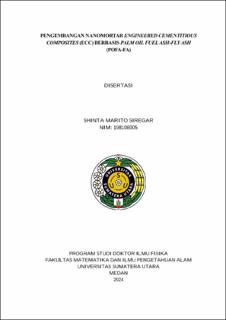| dc.description.abstract | This research aims to explore the influence of POFA and FA nanoparticle composition as a cementitious material in nanomortar POFA-FA ECC on mechanical properties (compressive strength and flexural strength), physical (XRD, SEM EDX Mapping and FITR), as well as absorption. The method that is used in this research is an experimental method with several stages, which are (1) POFA and FA waste synthesis with the top down method using a ball mill, (2) physical testing (XRF, XRD, SEM, FTIR) on POFA and FA (3) mix design (4) trial mix (slump flow test and pressure test), (5) creating test objects, dan (6) characterization. The result of the experiment depicts, with the top down method using a ball mill provides optimum results on nano sized synthetic materials with a POFA particle size of 7,61 nm containing SiO2 = 48,9%, Fe2O3 = 3,42%, CaO = 13,8% and the FA particle size of 16,46 nm containing SiO2 = 29,3%, Al2O3 = 14%, Fe2O3 = 30,9%, CaO = 18,3%, this indicates that POFA and FA are cementitious dan pozzolanic, hence it greatly influences the cement hydration binding process in ECC mortar. The development of POFA-FA ECC nanomortar shows significant results, this can be seen in the SEM EDX Mapping result that not many cavities are formed, additionally, the equal distribution of the elements Si, Ca dan Fe can be seen and this illustrates that homogenous nanomortar POFA-FA ECC nanomortar, therefore resulting in a nanomortar that possesses a high mechanical property. This is proven from almost all nanomortar POFA-FA ECC variation at the age of 28 days with a water absorption value of 0,43%-2,11%, a compressive strength of 46,34-72,73 MPa and flexural strength of 8,42-14,55 MPa has a value above the Indonesian National Standard value for normal concrete. | en_US |


